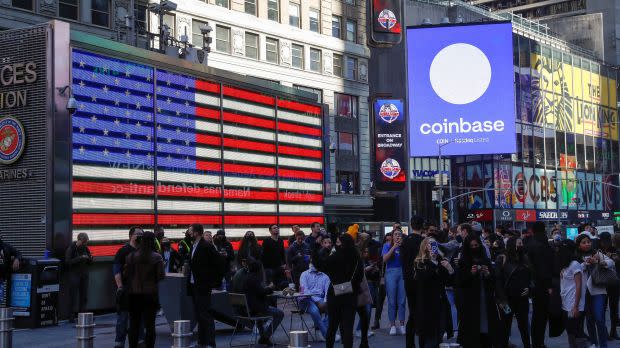What Coinbase’s entry into the NFT market means for OpenSea

Nifty Gateway, SuperRare, and MakersPlace were among the early entrants to establish a foothold in the market for non-fungible tokens (NFTs). But the website OpenSea has since established a chokehold on it.
OpenSea, which handled about 35% of NFT trading volume between February and April (including a Quartz article sold at auction in March), has increased its market share to more than 95%, making it the top player by far in the business of matching buyers and sellers of what is essentially proof of ownership, stored on a blockchain, for a digital asset.
Of the $2.8 billion spent on NFT marketplaces in September, $2.72 billion changed hands on OpenSea, according to data from the crypto websites Dapp Radar and CryptoArt, compiled by the The Block. In comparison, SuperRare saw less than $25 million in trading volume in September, good enough for second place among NFT marketplaces.
While OpenSea looks like it has quickly exerted control over the NFT market, its dominance may be threatened by an approaching incumbent in crypto. Coinbase, the world’s second largest crypto exchange, announced on Oct. 12 that it is creating its own NFT marketplace. It’s a direct challenge to OpenSea, one that will test the fortitude of the top player in an emerging market.
NFTs for the masses
In order to transact on OpenSea, users must purchase the cryptocurrency ether on a crypto exchange like Coinbase and set up a crypto wallet like MetaMask to connect to the platform. A Coinbase NFT platform could simplify the process by allowing customers to directly purchase NFTs on the exchange with a credit or debit card.
NFTs are still a niche business. Over the last month, there were only about 10,000 active NFT wallets each week, according to the website Nonfungible. But Coinbase, which has 68 million users (pdf), could introduce NFTs to a much wider audience. For Coinbase customers who are already involved in the NFT market, the prospect of having a single home for cryptocurrencies and NFTs could be appealing, while those who are new to the tokens will find a relatively simple pathway to buy or sell them.
“The company is betting on differentiating itself with a simple [user interface] that demystifies the NFT process and makes it more accessible to the everyday creator and collector,” said Mike Proulx, a vice president at the market research firm Forrester.
Comparing OpenSea and Coinbase
Being a relative old-timer, technically speaking, OpenSea is in a good position. It supports multiple kinds of blockchains, offers strong analytics, and has built credibility with verified user profiles, all of which will make it difficult to dislodge as the dominant NFT marketplace.
Coinbase, however, opens NFTs up to a whole new audience. The company is among the go-to platforms for all things crypto, especially for noobs. By reducing the friction of getting started in the NFT market and letting customers buy an NFT simply with a credit or debit card, Coinbase is all but assured a piece of this burgeoning business.
“Many say that Coinbase will be OpenSea killer, and it certainly has the potential to be that,” said Pedro Herrera, senior blockchain analyst at the crypto research firm DappRadar. “At this stage, I’d say that it will hinder OpenSea’s dominance, but for the time being OpenSea will remain a premier marketplace. Either way, I’m getting my popcorn out."
Sign up for the Quartz Daily Brief, our free daily newsletter with the world’s most important and interesting news.
More stories from Quartz:

